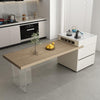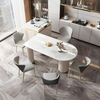How to Choose the Right Island Table for Your Kitchen Style and Space Size

Introduction:
The kitchen is often considered the heart of the home, and having a functional and visually appealing kitchen space is important for many homeowners. One element that can greatly enhance both the functionality and aesthetics of a kitchen is an island table. An island table is a standalone workstation located in the center of the kitchen that can be used for various purposes such as cooking, dining, and storage. Choosing the right island table that suits your kitchen style and space size is essential to maximize its benefits. In this comprehensive guide, we will explore the various aspects to consider when selecting an island table, including its definition, reasons for choosing it, sizing guidelines based on kitchen space, style considerations, and tips for utilizing it to enhance both functionality and aesthetics.

Section 1: What is an Island Table and Why Choose It?
To start off, let's delve into the concept of an island table and understand why it is a popular choice for many homeowners.
1.1 Island Table Definition:
An island table is a freestanding piece of furniture that serves as a versatile workstation in the kitchen. It is usually positioned in the center of the kitchen, providing a dedicated area for cooking, dining, and storage purposes. Unlike traditional kitchen countertops, an island table is separate from the other kitchen elements and offers additional functionality and aesthetic appeal.
1.2 Reasons to Choose an Island Table:
There are several compelling reasons why homeowners opt for an island table in their kitchens:
- Increased functionality: An island table expands the available workspace, allowing for more efficient meal preparation, cooking, and baking. It provides an extra surface area for chopping, mixing, and assembling ingredients, reducing the need to move around the kitchen.
- Additional storage: Many island tables feature built-in cabinets, drawers, or shelves, providing valuable storage space for kitchen utensils, pots, pans, and other essential items. This helps to declutter the main kitchen area and keep things organized.
- Dining area convenience: With an island table, you can create a designated space for casual dining or quick meals. It eliminates the need for a separate dining table, making it convenient for both everyday use and entertaining guests.
- Enhanced interaction: By positioning an island table in the center of the kitchen, it becomes a focal point for socializing and interaction. Whether it's having conversations while preparing meals or engaging in activities with family and guests, the island table facilitates a sense of togetherness.
- Aesthetically pleasing: Island tables come in various designs, materials, and styles, allowing homeowners to add a unique touch to their kitchen decor. They can serve as a statement piece that elevates the overall aesthetics of the kitchen.

Section 2: Choosing the Right Island Table Based on Kitchen Space Size
When selecting an island table, it is crucial to consider the available space in your kitchen. In this section, we will explore guidelines to help you choose an island table that is proportionate to your kitchen size and ensures optimal functionality.
2.1 Ensuring Sufficient Surrounding Space:
To ensure comfortable movement within the kitchen and convenient access to cabinets and drawers, it is important to provide adequate surrounding space for the island table. Consider the following tips:
- Maintain a distance of at least 90 centimeters (or 36 inches) between the island table and other kitchen elements, such as countertops, walls, and appliances. This allows enough space to maneuver and prevents any obstruction.
- Ensure there is ample space to open cabinet doors and drawers without any restrictions. Take into account the swing radius of the doors and the clearance required.
- Consider the workflow in your kitchen. The island table should be positioned in a way that does not disrupt the natural flow of movement between the main work areas, such as the sink, stove, and refrigerator.
2.2 Sizing Guidelines for Island Tables:
Choosing the appropriate size for your island table is crucial for harmonizing with your kitchen space. Consider the following guidelines:
- Length: The length of the island table should be proportionate to the available space in your kitchen. As a general rule, it should range between 120 to 240 centimeters (or 48 to 96 inches). This provides enough surface area for various activities without feeling crowed.
- Width: The width of the island table should typically be between 60 to 120 centimeters (or 24 to 48 inches). This ensures a comfortable work surface while allowing adequate space for movement around the table.
- Height: The standard height for an island table is between 90 to 110 centimeters (or 36 to 44 inches). However, it is essential to consider the height of the users and their preferred ergonomic comfort. Adjustments can be made accordingly.
2.3 Considering Kitchen Layout and Shape:
In addition to size, the shape of the island table plays a significant role in its compatibility with the kitchen layout. Here are some considerations:
- Rectangular or square island tables: These shapes are suitable for kitchens with a rectangular or square layout. They align well with straight walls and provide a clean, symmetrical look.
- Circular or oval island tables: These shapes are ideal for kitchens with a circular or irregular layout. They soften the overall appearance of the kitchen and create a more organic flow.
- Other irregular shapes: If your kitchen has a unique layout or you desire a distinctive designelement, consider exploring custom-made island tables with irregular shapes. These can be tailored to fit the specific contours of your kitchen space, making them a striking focal point.
Section 3: Choosing the Right Island Table Based on Kitchen Style
The style of the island table is an important aspect to consider as it should harmonize with the overall design scheme of your kitchen. In this section, we will explore different factors to keep in mind when selecting an island table based on your kitchen style.
3.1 Materials for Island Tables:
Island tables are available in a wide range of materials, each offering a unique aesthetic appeal and functionality. Consider the following options:

- Wood: Wooden island tables exude warmth and natural beauty. They can range from light-colored hardwoods like oak and maple to darker tones like walnut and cherry. Wood is a versatile material that complements various kitchen styles, including modern, rustic, and traditional.
- Metal: For a contemporary or industrial-style kitchen, metal island tables can be an excellent choice. Materials like stainless steel or wrought iron add a sleek and sophisticated touch, and they are highly durable and easy to maintain.
- Glass: If you prefer a minimalist or sleek look, a glass island table can be an elegant choice. The transparent surface creates a sense of lightness and openness, making it suitable for smaller kitchens that aim to maximize visual space.
- Marble and Granite: Island tables made from marble or granite exude luxury and elegance. They are highly durable and heat-resistant, making them suitable for busy kitchens. Marble offers a classic, timeless appeal, while granite provides a more contemporary touch.
- Sintered Stone: Sintered stone is a relatively new material that combines the durability and strength of natural stone with advanced manufacturing techniques. It is highly resistant to scratches, heat, and stains, making it suitable for a wide range of kitchen styles.
3.2 Color Considerations:
The color of the island table can significantly impact the overall visual appeal of the kitchen. Here are some tips for choosing the right color:
- Monochromatic or light colors: Light-colored island tables, such as white, cream, or pastel shades, can create a sense of spaciousness and brightness. They work well in smaller kitchens or kitchens with a predominantly dark color scheme, helping to balance the overall visual impact.
- Multicolor or dark colors: Dark-colored island tables, such as black, espresso, or deep hues, can make a bold statement in larger kitchens or kitchens with lighter color schemes. They add depth and richness to the space, creating a focal point.

3.3 Style and Design:
The style of the island table should align with your personal preferences and the overall design theme of your kitchen. Consider the following factors:
- Simple and sleek: If you prefer a clean and minimalist aesthetic, opt for a simple and streamlined island table design. Smooth surfaces, straight lines, and minimalist details can create a contemporary and uncluttered look.
- Intricate and detailed: For a more traditional or ornate style, consider an island table with intricate details, such as carved accents, decorative moldings, or paneling. These details add a touch of elegance and can complement kitchens with a classic or vintage design.
- Mixed materials: Some island tables incorporate a combination of different materials, such as wood and metal or wood and stone. These mixed-material designs can add visual interest and create a unique focal point in the kitchen.
Section 4: Utilizing the Island Table to Enhance Functionality and Aesthetics
Once you have chosen the right island table for your kitchen, it's time to make the most of its functionality and enhance the overall aesthetics. In this section, we will provide tips and ideas on how to maximize the potential of your island table.
4.1 Functional Enhancements:
An island table can serve multiple purposes beyond just a workspace. Consider the following functional enhancements:
- Cooking station: If you enjoy cooking and want to streamline your meal preparation process, consider incorporating cooking appliances into the island table. This can include features such as a built-in stove, oven, or even a sink for easy access to water.
- Dining area: Make your island table a dedicated space for dining by adding bar stools or chairs. This creates a casual dining area that is convenient for quick meals or entertaining guests.
- Storage solutions: Utilize the storage potential of the island table by incorporating cabinets, drawers, or shelves. This allows for easy access to frequently used items and helps to declutter your kitchen countertops.
- Display area: Showcase your favorite kitchenware, cookbooks, or decorative items on open shelves or glass-front cabinets. This adds a personalized touch to your kitchen and creates a focal point on the island table.

4.2 Aesthetic Enhancements:
Beyond its functional role, an island table can contribute to the overall aesthetics of your kitchen. Consider the following aesthetic enhancements:
- Lighting: Install pendant lights or chandeliers above the island table to create a visually appealing focal point. The lighting fixtures can complement the style of your kitchen while providing task lighting for the workspace.
- Decorative accents: Add decorative elements such as vases, fruit bowls, or plants to bring life and vibrancy to your island table. Choose items that align with your kitchen style and color scheme.
- Tableware and accessories: Display stylish and coordinated tableware, such as elegant dinnerware or statement pieces, on your island table. This adds a touch of sophistication and elevates the visual appeal.
- Decorative finishes: Consider adding decorative finishes, such as tile backsplashes or ornamental trims, to enhance the overall look of the island table. These finishes can complement the materials used in your kitchen and create a cohesive design.
4.3 Creating Ambiance:
The island table can also contribute to the ambiance and atmosphere of your kitchen. Consider the following tips:
- Music and entertainment: Install speakers or a sound system in the kitchen to play music while you cook or dine. This creates a lively and enjoyable environment.
- Scents and candles: Use scented candles, diffusers, or fresh flowers on the island table to introduce pleasant aromas into your kitchen space. This adds a sensory dimension and enhances the overall ambiance.
- Personal touches: Incorporate personal elements, such as artwork, photographs, or sentimental objects, on your island table. These items reflect your personality and create a warm and inviting atmosphere.
Conclusion:
Choosing the right island table for your kitchen involves considering factors such as size, style, materials, and functionality. By carefully selecting an island table that suits your kitchen space and aligns with your design preferences, you can enhance both the functionality and aesthetics of your kitchen. Remember to consider the surrounding space, follow sizing guidelines, and choose materials and colors that harmonize with your kitchen style. Finally, explore functional and aesthetic enhancements to maximize the potential of your island table and create a kitchen space that is not only practical but also visually appealing and enjoyable for all.





